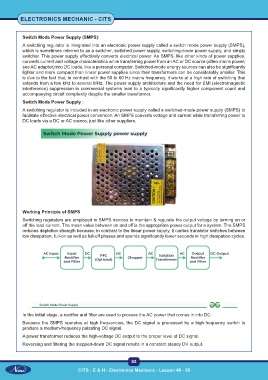Page 97 - CITS - Electronic Mechanic - TT - 2024
P. 97
ELECTRONICS MECHANIC - CITS
Switch Mode Power Supply (SMPS):
A switching regulator is integrated into an electronic power supply called a switch mode power supply (SMPS),
which is sometimes referred to as a switcher, switched power supply, switching-mode power supply, and simply
switcher. This power supply effectively converts electrical power. An SMPS, like other kinds of power supplies,
converts current and voltage characteristics while transferring power from an AC or DC source (often mains power;
see AC adapter) into DC loads, like a personal computer. Switched-mode energy sources can also be significantly
lighter and more compact than linear power supplies since their transformers can be considerably smaller. This
is due to the fact that, in contrast with the 50 to 60 Hz mains frequency, it works at a high rate of switching that
extends from a few kHz to several MHz. The power supply architecture and the need for EMI (electromagnetic
interference) suppression in commercial systems lead to a typically significantly higher component count and
accompanying circuit complexity despite the smaller transformer.
Switch Mode Power Supply :
A switching regulator is included in an electronic power supply called a switched-mode power supply (SMPS) to
facilitate effective electrical power conversion. An SMPS converts voltage and current while transferring power to
DC loads via a DC or AC source, just like other suppliers.
Working Principle of SMPS
Switching regulators are employed in SMPS devices to maintain & regulate the output voltage by turning on or
off the load current. The mean value between on and off is the appropriate power output for a system. The SMPS
reduces depletion strength because, in contrast to the linear power supply, it carries transistor switches between
low dissipation, full-on as well as full-off phases and spends significantly fewer seconds in high dissipation cycles.
In the initial stage, a rectifier and filter are used to process the AC power that comes in into DC.
Because the SMPS operates at high frequencies, the DC signal is processed by a high-frequency switch to
produce a medium-frequency pulsating DC signal.
A power transformer reduces the high-voltage DC output to the proper level of DC signal.
Reversing and filtering the stepped-down DC signal results in a constant steady DV output.
82
CITS : E & H - Electronics Mechanic - Lesson 48 - 55

